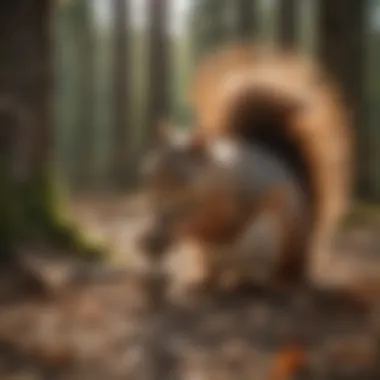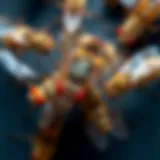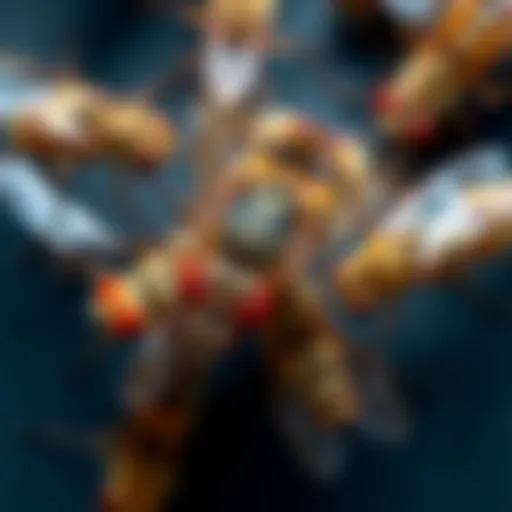The Ultimate Guide to Choosing Squirrel Traps


Pest Identification
Common Household Pests
When delving into the world of pest control, recognizing the specific nuisances that invade our spaces is paramount. Squirrels, particularly the Eastern Gray Squirrel and the Fox Squirrel, are often the culprits of household disturbances. They are agile and curious animals, drawn to residential areas due to the availability of food and shelter.
Other common household pests include mice, rats, and certain insects. However, this guide will focus primarily on squirrels. These creatures can often be spotted scurrying along rooftops or raiding bird feeders. Their presence may seem innocuous at first, but as their populations grow, they can pose significant risks to homes and gardens alike.
Signs of Infestation
Identifying the signs of a squirrel infestation is crucial to taking timely action. Look for the following indicators:
- Nesting Materials: Torn insulation or shredded leaves in attics.
- Droppings: Squirrel droppings are about a quarter-inch long, rod-shaped, and may be found near feeding sites or nests.
- Gnaw Marks: Squirrels have a tendency to chew on wood, plastic, and even electrical wires, which can lead to serious damage.
- Noises: Scratching sounds in the walls or ceilings during early morning or late evening can indicate squirrels are present.
If you suspect an infestation, early intervention is key. Ignoring the signs may lead to property damage and potential health risks.
Prevention Methods
Environmental Modifications
Preventing a squirrel infestation often begins with simple modifications to the environment. Consider implementing these strategies:
- Remove Food Sources: Keep pet food, bird seed, and fallen fruit off the ground. Secure trash bins with tight-fitting lids.
- Landscaping: Trim back tree branches that hang close to the roof. This reduces the chance of squirrels gaining access to your home.
- Sealing Entry Points: Inspect your home for holes or gaps around vents, chimneys, and roofs. Use materials such as metal mesh or caulk to close these openings.
Home Maintenance Tips
Maintaining a clean and secured property is vital in deterring squirrels.
- Regular Inspections: Check your home periodically for signs of wear and vulnerabilities.
- Secure Vent Covers: Ensure attic and basement vents are covered properly to prevent access.
- Keep Basement and Attics Dry: Moisture can attract various pests, including squirrels.
DIY Pest Control Solutions
Natural Remedies
For those seeking eco-friendly methods, several natural remedies may prove useful against squirrels. Consider:
- Essential Oils: Oils such as peppermint and cinnamon can deter squirrels. Mix with water and spray around entry points.
- Vinegar: A mixture of vinegar and water can be sprayed in areas where squirrels tend to frequent.
DIY Traps and Barriers
Creating traps at home can be an effective way to manage squirrel populations. For example:
- Bucket Traps: Set up a bucket trap with bait inside. As squirrels attempt to reach the bait, they fall into the bucket.
- Wire Mesh Barriers: Construct barriers around gardens or bird feeders using wire mesh. This can prevent squirrels from accessing food sources.
"Knowledge of one's environment and effective modification strategies can be more impactful than merely addressing the symptoms of an infestation."
Effective squirrel management involves an understanding of their behaviors and your surroundings. Whether through modifications, maintenance, or DIY approaches, being proactive can ensure your home stays pest-free.
Intro to Squirrel Trapping
Squirrel trapping is an essential practice for homeowners and property managers. This activity plays a significant role in maintaining the balance within ecosystems while preventing property damage. Understanding the need for squirrel control is foundational when engaging in this practice. The population of squirrels can quickly escalate, leading to various challenges for residents, from physical damage to homes and gardens to potential health risks.
Importance of Squirrel Control
The necessity of squirrel control extends beyond mere inconvenience. Squirrels are known to cause property damage, particularly when they invade attics or chew on electrical wires. Such activities can lead to costly repairs and necessary renovations. Furthermore, they can also pose health risks by carrying diseases. Their droppings and nesting materials can lead to contamination, affecting indoor air quality and posing hazards to inhabitants.
Additionally, managing squirrel populations responsibly offers ecological benefits. Squirrels can compete with native species for resources. This can disrupt local biodiversity when their numbers are not kept in check. Effective squirrel control is not just a question of convenience but a step towards responsible property stewardship and ecological balance.
Overview of Multiple Squirrel Traps
Multiple squirrel traps come in various designs and mechanisms, each serving specific purposes and targeting different needs. They can either be live-catch traps, which allow one to capture squirrels humanely, or kill traps that aim to eliminate them instantly.
The efficiency of these traps relies on understanding their operation and selecting the appropriate type based on one's circumstances. Choosing the right trap reflects not only on successful squirrel capture but also aims for humane considerations in pest management. Each type has its features and functions that merit exploration for informed decisions.
"Understanding the operational mechanisms of various traps fosters better and more ethical pest control practices."


In the subsequent sections of this guide, we will delve deeper into the various types of traps available, their benefits, and considerations on how to choose an effective trap. This knowledge is crucial for any homeowner or professional involved in wildlife management.
Types of Multiple Squirrel Traps
Understanding the various types of multiple squirrel traps is fundamental for effective squirrel management. Each trap offers unique mechanisms and advantages that suit different situations. Homeowners must assess their specific needs and the squirrel activity in their area to determine the right type of trap. This section focuses on three primary types: live catch traps, kill traps, and collapsible traps, each with distinct features and considerations, contributing to a more effective trapping strategy.
Live Catch Traps
Mechanism of Action
Live catch traps operate primarily through a trigger mechanism that activates when a squirrel enters the trap for bait. These traps allow for the capture of a squirrel without causing harm. The key characteristic of live catch traps is their design, which keeps the animal secure while minimizing stress. Their use is beneficial for those who prefer to relocate rather than eliminate the animal. However, it is essential to ensure that the trap is sufficiently sturdy to prevent the captured squirrel from escaping.
Benefits of Live Catch
Live catch traps provide numerous benefits, especially for homeowners concerned about animal welfare. A significant benefit is that they allow for the humane capture of squirrels, enabling the option for release in an appropriate environment away from residential areas. Another unique feature is their capability to capture multiple squirrels, which can be crucial when dealing with an infestation. Despite these advantages, they require regular monitoring to ensure that trapped animals do not suffer due to prolonged confinement.
Considerations for Release
Considerations for the release of captured squirrels are vital for responsible trapping. It is crucial to identified suitable release locations that are away from homes and human activity to prevent the squirrels from returning. Legal regulations in many areas dictate how and where animals can be released, emphasizing the importance of compliance. A unique aspect of this consideration involves understanding the ecological impact of reintroducing squirrels into a new habitat, which could disrupt the local ecosystem.
Kill Traps
Types of Kill Traps
Kill traps are designed to quickly and effectively eliminate the target animal. There are various types, including snap traps and electronic traps. The key characteristic of kill traps is their efficiency, as they function to immediately eradicate the squirrel upon activation. For homeowners with significant squirrel problems, these traps offer a straightforward solution. However, it's important to assess the potential for non-target animals to be affected, which can be a significant drawback of this method.
Ethical Considerations
The use of kill traps raises several ethical considerations. Some individuals regard the use of such traps as inhumane, primarily if they do not operate correctly, causing suffering. It is essential to ensure that the traps used are designed for a quick kill, aligning with best practices in animal control. A critical aspect of this issue is the balance between effective pest control and humane treatment of animals. Understanding local sentiment and regulations on kill traps can influence their acceptance and implementation.
Proper Disposal Techniques
Proper disposal of deceased animals is crucial following the use of kill traps. Homeowners should be informed about health and safety issues related to handling and disposing of dead squirrels. Certain guidelines often exist at a local level regarding this process, typically requiring that carcasses be buried, burned, or placed in a sealed bag for waste disposal. This unique feature of kill traps emphasizes the responsibility of the user to manage both the capture and aftermath efficiently.
Collapsible Traps
Ease of Storage
Collapsible traps offer significant benefits in terms of storage. Their design allows them to be folded down when not in use, thereby requiring minimal space. This characteristic is especially helpful for homeowners who may not have a dedicated area for trapping equipment. Storing these traps properly can prolong their lifespan and maintain their effectiveness for future use. However, the ease of storage should not come at the expense of their structural integrity after multiple uses.
Set-Up Instructions
Setting up collapsible traps is relatively straightforward and often involves following simple instructions. These traps usually come with clear setup guidelines, allowing homeowners to deploy them with little hassle. A unique aspect of collapsible traps is that they often feature automatic triggers, simplifying the user’s interaction with the mechanism. Nevertheless, ensuring that the trap is properly set is critical to avoid ineffective trapping due to misalignment or improper preparation.
Choosing the Right Trap
Selecting the appropriate trap really matters for effective squirrel control. A well-chosen trap can lead to successful captures while minimizing stress for both the squirrels and the person handling the traps. This section will guide readers through essential factors in selecting the right trap.
Assessing Your Specific Needs
To begin, evaluating specific needs is paramount. Homeowners should consider factors like the squirrel problem size and location. Are there many squirrels, or just a few? Locations also matter. An urban environment may call for different strategies than a rural area. Additionally, understanding whether you prefer live trapping or lethal methods influences your choice significantly.
Evaluating Trap Features
Material Durability
Material durability is crucial in selecting a trap. Traps made from high-quality metals, such as galvanized steel, resist rust and can withstand harsh outdoor conditions. The key characteristic of durable materials is their longevity. Using a durable trap means you can rely on its performance over time. One unique feature is that metal traps are generally heavier, preventing squirrels from easily moving or tipping them. This durability can ultimately save money, as replacements are less frequent.
Size and Dimensions
Size and dimensions are another significant consideration. Traps come in various sizes, and selecting one that matches the type of squirrel is essential. Standard dimensions might not work for larger species, while smaller traps can be ineffective for bolder squirrels. A key characteristic of proper dimensions ensures a balance between capacity for multiple catches and ease of use. For instance, a compact trap might be easier to set up but may not accommodate larger captures. Thus, understanding these traits assists in making informed selections.
Trigger Mechanism
A trap's trigger mechanism is vital to its effectiveness. Various designs exist, like spring-loaded and magnetic triggers. A major advantage of a sensitive trigger is its higher success rate for captures. Furthermore, many modern traps feature adjustable tension settings. This unique feature allows customization to match squirrel behavior, making the trap more effective. However, selecting a trap with complex mechanisms may require additional skill to operate.
Brand Comparisons


When deciding on traps, brand reputation plays a critical role in ensuring quality. Learning about manufacturers can guide choices.
Reputable Brands
Focusing on reputable brands helps in purchasing reliability. Brands that have developed a positive rapport in the market often reflect quality and efficacy. A key characteristic of reputable brands is their proven track record in performance. Moreover, well-known brands may offer warranties, indicating confidence in their products. Unique features may include innovative designs that enhance functionality or ease of use.
Customer Reviews
Customer reviews provide a real-world confirmation of a product's effectiveness. They reveal user experiences and common pitfalls, leading to more informed decisions. A significant aspect of customer reviews is their authenticity. Readers can discern what works and what doesn't based on a wide array of feedback. This transparency is beneficial but should also be approached with discernment, understanding that experiences vary.
Price vs. Quality
Finally, price versus quality is a vital consideration. Often, lower-priced traps might lack features or durability found in higher-end options. A key point here is the balance between budget constraints and investment in a reliable solution. One unique element in evaluating price and quality is the potential long-term savings represented by choosing a trustworthy trap. Investing in a quality trap can lead to a reduction in frequent replacements and ineffective strategies, making it a wise choice for the discerning homeowner.
Setting Up Multiple Squirrel Traps
Setting up multiple squirrel traps is a crucial aspect of effective squirrel management. Proper setup increases the likelihood of successful trapping and minimizes stress on the animals. It is essential to understand the environment and behavior of squirrels to place traps in the right locations. Additionally, using the appropriate bait and monitoring the traps regularly will enhance the overall effectiveness of your efforts.
Identifying Prime Locations
Signs of Squirrel Activity
Recognizing signs of squirrel activity is the first step in effectively identifying where to place your traps. Squirrels are generally active during the day, and their presence can be indicated by several signs. Look for chewed nuts, gnawed wood, and shredded nesting materials. Tracks or droppings can also signify their movements.
The key characteristic of recognizing signs of squirrel activity is that it allows for strategic trap placement. It is a practical choice for homeowners because it increases the chances of success in capturing squirrels. Noticing these signs may require keen observation skills and patience, but it significantly boosts the chances of getting results. The unique feature of this approach is that it is non-invasive; it does not frighten away the squirrels while you are preparing for trapping.
Strategic Placement Techniques
Understanding how to place traps strategically is equally important. By positioning traps near food sources or nesting areas, you increase the odds of catching squirrels. Pay attention to locations such as near trees or near storage sheds where squirrels are known to forage.
The strategic placement of traps is beneficial because it ensures that your traps are in high-traffic areas, making them more effective. The unique benefit of this technique is that it allows for adaptability; you can adjust positions based on your observations of squirrel behavior. However, relying solely on this method may require constant monitoring to ensure traps remain effective over time.
Baiting Techniques
Choosing Effective Baits
Selecting the right bait is critical for trapping squirrels. Certain types of food will attract them more effectively than others. For instance, peanut butter, sunflower seeds, and apples are known to be highly effective baits for attracting squirrels. The effectiveness stems from their natural diet and preferences.
The key characteristic of choosing effective baits is that it appeals specifically to the target animal's preferences. This choice is popular among trappers because it enhances efficiency, increasing the likelihood of capture. The unique aspect of using these baits is that it encourages squirrels to enter the trap, resulting in less chance of escape. Still, it is vital to replace spoiled bait regularly to maintain its attractiveness.
Bait Placement Strategies
Proper bait placement is just as important as the bait itself. Bait should be placed inside the trap so that squirrels must enter to access it. Additionally, placing bait near the entrance can help guide squirrels into the trap.
This approach is beneficial as it maximizes the chances of capturing the animal while minimizing waste. The unique feature of this strategy is that it can be adjusted based on the specific behavior of squirrels in your area. However, care must be taken to avoid over-baiting, which can lead to false signals when monitoring trap activity.
Monitoring Traps
Regular Check-Ups
Regular check-ups are essential once traps are set. Frequent checks help ensure that trapped animals are not left for extended periods, which is critical for humane treatment. It also allows for immediate removal of captured squirrels, preventing stress and potential harm to the animal.
Monitoring traps on a daily basis is a critical practice that protects the welfare of the captured squirrels. The key aspect of regular check-ups is accountability. Keeping a check on traps is a responsible practice for any trapper. However, this commitment requires time and diligence, especially for those managing multiple traps.
Contingency Plans
Having contingency plans is another important consideration in the trapping process. Unexpected situations can arise, such as traps being affected by weather or animals not entering as anticipated. Preparing for these possibilities helps in maintaining effective trapping.
This aspect of trapping contributes greatly to successful management efforts. The key characteristic of contingency planning is its proactive nature. By anticipating challenges, you can adjust tactics and possibly improve outcomes. The unique benefit to having a plan is that it fosters adaptability and resilience in your approach. However, it can require further assessment of resources and time for implementation.
In summary, setting up multiple squirrel traps with attention to detail is fundamental. By learning to identify prime locations, using effective baits, and monitoring traps diligently, homeowners can create a comprehensive approach to managing squirrel populations.
Legal and Ethical Considerations
Understanding the legal and ethical considerations of squirrel trapping is essential for homeowners and pest control professionals. As wildlife management practices become more scrutinized, adhering to regulations is crucial to ensure humane treatment of animals and compliance with local laws. Not only does this protect the environment, but it also upholds community standards regarding animal welfare. Knowing the legal implications can prevent fines or legal actions arising from improper trapping practices.
Understanding Local Regulations


Every region has its own set of laws regarding trapping and dealing with wildlife. It is vital for individuals to familiarize themselves with these regulations. The laws may vary significantly between states or even municipalities. In many places, trapping squirrels requires a permit or specific licenses.
Failure to comply with local laws not only carries potential fines but also jeopardizes the overall ethics of wildlife management practices. Engaging with local wildlife agencies can provide accurate information. Always make sure to consult your local regulations and follow them diligently. This includes checking whether certain traps are legal, the allowable methods of dispatching trapped animals, and required reporting processes.
Ethics of Animal Control
The ethical aspect of animal control deals with the treatment of the species involved. When dealing with squirrel populations, it is imperative to follow humane practices. Live traps are often recommended because they allow for release at a later time. However, the release must be done responsibly and at a significant distance from your property to prevent them from returning.
It is also essential to consider the ecological impact of squirrel trapping. Unlike some animals, squirrels provide benefits in their ecosystems, such as seed dispersal. Removing them indiscriminately could have long-term repercussions on local biodiversity. Therefore, educating oneself on the roles these animals play is vital.
Post-Trapping Procedures
Post-trapping procedures are crucial in the overall process of squirrel management. Once you have successfully trapped a squirrel, the way you handle the situation can significantly impact animal welfare and your own safety. Addressing the correct procedures ensures compliance with ethical standards and local regulations.
Humane Handling of Captured Squirrels
Humane handling of captured squirrels is essential. This means treating the animals with care and respect, even if they are seen as pests. It is important to avoid causing undue stress or harm. When approaching a live catch trap, stay calm and speak softly to avoid startling the squirrel further. Gently cover the trap with a blanket or towel to help keep the squirrel calm. If possible, relocate the animal at a safe distance from your property, in accordance with local laws.
Engaging professionals for relocation may sometimes be the best choice. They have experience in handling wildlife humanely. Always ensure that the new environment is suitable for the squirrel’s survival.
Disposal of Dead Animals
Disposal of dead animals is another critical area of post-trapping procedures that must address health and safety concerns as well as local regulations. Failure to properly deal with deceased squirrels can lead to health risks and potential legal issues.
Health and Safety Issues
When dealing with dead animals, health and safety issues are paramount. Squirrels can carry diseases that are transmissible to humans and pets. Proper gloves should be worn when handling dead animals to avoid direct contact. It is important to seal the carcass in a plastic bag securely. Once contained, the bag should be placed in a second bag to ensure no leakage occurs. Dispose of it according to local waste management guidelines to protect public health. Adhering to these practices minimizes any potential health risks.
Local Guidelines
Local guidelines play a crucial role in the safe disposal of dead animals. Many communities have specific regulations about how to handle deceased wildlife. It is essential to familiarize yourself with these regulations to remain compliant. Ignoring them might result in fines or more serious legal repercussions. Many municipalities require that dead animals be reported to animal control. This can ensure that the remains are handled correctly, often with resources dedicated to wildlife management.
These local guidelines are beneficial in maintaining public health and safety. They provide clarity on the legal obligations concerning animal disposal, minimizing confusion for residents. By following these regulations, homeowners not only protect themselves but also contribute to broader community efforts in responsible wildlife management.
Preventive Measures Against Future Infestations
Effective squirrel control is not just about trapping; it also involves proactive measures. Preventive steps are integral to minimizing the chances of future infestations. Without them, even the best trapping methods may only provide temporary relief. By understanding and implementing these measures, property owners can maintain a more harmonious environment, reducing potential conflicts with squirrels.
Excluding Squirrels from Your Property
To exclude squirrels from your property, it is vital to identify potential entry points. These can include gaps in attics, openings in eaves, and cracks on exterior walls. Once identified, you can take measures to seal these gaps. Hardware cloth or screens are effective tools for blocking entry. Regular inspections are beneficial to catch any new vulnerabilities early.
Additionally, trees that are too close to your home should be trimmed. Branches can act as highways for squirrels, allowing them easy access to roofs. Removing or reducing nursery sites plays a crucial role in controlling their population.
Maintaining a Squirrel-Free Environment
Removing Food Sources
One major attractant for squirrels is food. Ensuring that food sources are removed from your yard is a significant step towards deterring them. This includes bird seed, pet food, and fallen fruit. Properly storing food in sealed containers helps to minimize access.
A clean garden space contributes to a squirrel-free environment. Maintaining strict trash protocols is necessary. Fallen seeds and open compost bins can be inviting for squirrels, so keep them well-secured.
Suitable Landscaping Practices
Landscaping can greatly influence squirrel activity. Using plants that are less appealing to squirrels is one aspect of effective land management. Opting for plants that are less likely to attract them is an informed choice.
Also, maintaining a tidy garden is essential. Overgrown shrubs and hedges can provide nesting sites or shelter. Regular trimming and cleanup help in keeping these areas less inviting.
By adopting strict landscaping practices, one can significantly reduce the likelihood of a squirrel infestation.
The End
In this guide, we have explored the various facets of multiple squirrel traps, emphasizing their significance in effective pest control. As homeowners, understanding the methods and choices available for trapping squirrels is crucial for maintaining our living spaces. The significance of using the correct traps can lead to humane and efficient management of squirrel populations.
Summary of Key Points
- Multiple squirrel traps come in different types including live catch and kill traps.
- Each type has its own benefits, mechanisms, and ethical considerations to keep in mind.
- Proper setup and monitoring of traps are essential for success in squirrel management.
- Legal regulations and ethical responsibilities must not be overlooked to ensure humane treatment of animals.
- Post-trapping procedures play a critical role in the responsible handling of captured squirrels and the disposal of deceased ones.
- Preventive measures, including property modifications and suitable landscaping practices, are essential for long-term squirrel control.
Final Thoughts on Multiple Squirrel Traps
Managing squirrel populations can be daunting, yet with the right knowledge and tools, it becomes manageable. Homeowners should take their time in selecting the appropriate types of traps and understanding their operation thoroughly. There is a balance between efficiency in control and ethical duties to protect wildlife. A thoughtful approach ensures not just the immediate resolution of a squirrel issue but also contributes to a sustainable and harmonious living environment.
By adhering to the best practices discussed within this guide, it is possible to achieve desired outcomes in squirrel trapping while upholding one’s responsibility as a homeowner. Considering these factors will enhance your effectiveness in using multiple squirrel traps and promote better coexistence with the wildlife in our neighborhoods.















